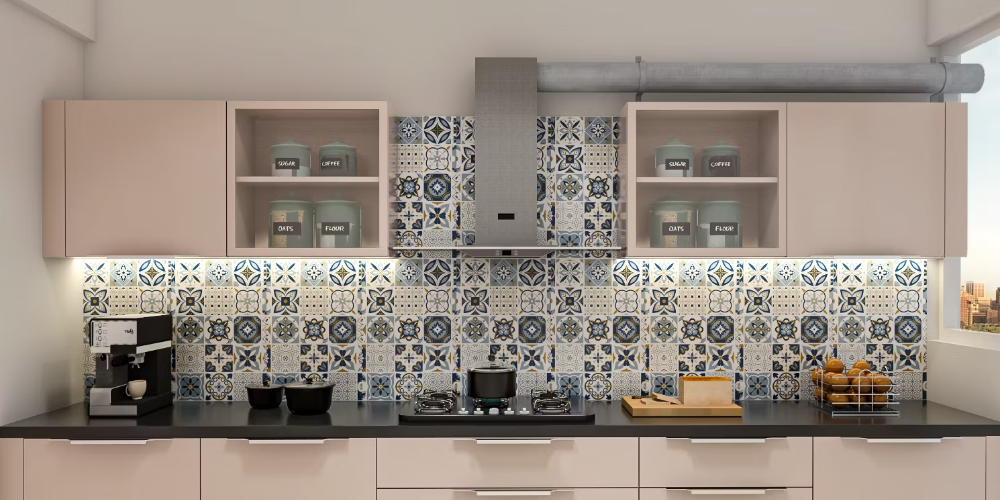
Copyright © DeCeramica
Why Should You Get Moroccan Tiles for Your Kitchen
Why Should You Get Moroccan Tiles for Your Kitchen
Inspired by encaustic tiles from the Middle Ages, Moroccan Tiles can be both on-trend and timeless. These finely-patterned tiles have been as much a rave back in the medieval period as they are in the millennial today.
Moroccan interiors are trendy yet able to carry on over time. When used in a kitchen, these tiles can transform an ordinary room into a glamorous retreat. They can add dimension in bright spaces while appearing as a welcome pop of color against minimal interiors. Let’s dig a bit and find what makes this variation of the modern kitchen the talk of the town.
The Pros & Cons of Moroccan Kitchen Tiles
Moroccan Kitchen tiles are one of the interior design’s reigning trends of the last few years. Although being in existence for centuries, these tiles are still believed to be the ultimate go-to decor strategy to flip the entire look of a place. And the resumption of Moroccan tiles each time is trendier than the last.
However, for all the beauty Moroccan tile designs have to offer, these have drawbacks, too. So, if you plan to upgrade your kitchen with Moroccan interiors, this guide is for you. Here’s a lowdown of the pros and cons of installing these tiles to help you make the right decision without getting swayed by their designs.
Moroccan Kitchen Tiles – Pros
- Complement any kitchen style
Moroccan tiles look appealing in all kitchen styles while adding luxurious vibes. Installing faded Moroccan-style tiles in the backsplash lends a trendy touch to the rustic space. Mediterranean-style homes are a perfect fit for such trendy interiors.
You can use Moroccan tiles to create an accent wall, making it appear a subtle masterpiece amid modern cabinetry and floors.
- Versatile
While the most popular spots for Moroccan tiles are undoubtedly kitchen backsplashes, bathroom floors, and fireplaces, they aren’t limited to those spaces. These are exceptionally versatile, and you can incorporate these contemporary masterpieces into other spaces, including stair risers, window frames, and wainscoting.
- Oozes timeless appeal and charm
If done right, Moroccan tiles can appear as timeless as natural stone tiles and grab onlookers’ eyeballs instantly. Farmhouse and rustic designs are the most preferred choices when choosing Moroccan-style tiles for a kitchen.
You can combine neutral and subtle patterned Moroccan tiles with evergreen choices, like wood, travertine stone, etc., to keep the design looking fresh for years.
Moroccan Kitchen Tiles – Cons
- High-Maintenance
The surface of Moroccan encaustic tiles isn’t protected by a glaze, and that’s why Moroccan-style tiles are prone to staining. Hence, you should treat them like natural stones and practice regular cleaning of these tiles. It’s vital to clean up spills and avoid prolonged exposure to moisture to add more years to its life.
- It might get out of trend in the coming years
As already mentioned, Moroccan tiles are trendy these days. And they may not the tomorrow’s version of mid-century fashion. Trends come and go, so you must invest in something that lasts longer. However, you can easily handle this disadvantage by pairing it with other contemporary items and making it look timeless.
How to Add Moroccan Tiles to Your Kitchen?
While the Moroccan decor trend complements any room of your house, the kitchen is a good place to start if you’re apprehensive about how the result would be. This trend can transform your ordinary-looking kitchen wall tiles into a classic retreat that instantly grabs attention.
Here’s how to use this subtle trend to create a Moroccan-style kitchen.
- Floor Tiles

It is the most common and effective way to incorporate Moroccan tiles into your kitchen. If you have a white or neutral-tone kitchen, add bold-colored Moroccan tiles to create a welcome pop of color.
However, you can also opt for monochromatic Moroccan tiles to give an edge to your bright-colored kitchen. Additionally, homeowners can try offbeat hues, like orange and brown, if they look harmonious with their existing kitchen decor.
- Backsplash Tiles

If you want to give your space a minimal makeover, then tearing down your kitchen floor for Moroccan tiles can be a big gamble. Hence, in that case, you should consider installing these tiles as a backsplash.
When choosing Moroccan-style tiles for the kitchen backsplash, the options are endless, and so does your imagination. You can use the same hues or create a well-balanced contrast to make a statement. Homeowners can also mix and match multiple Moroccan tile designs for an artistic look.
If you have glossy laminates, you can use muted Moroccan tiles to bring down the extra shine.
- Countertops

Yet another simple yet practical way to add a hint of Moroccan decor to your kitchen is to use them on the countertops. Moroccan countertops enhance the overall beauty and aesthetics of your kitchen while adding longevity.
Combine Moroccan countertops with Moroccan backsplash tiles to achieve a bohemian look. You can also spice up the entire look by adding these tiles to your breakfast table.
Summing Up
From your Kitchen backsplashes to your staircases, Moroccan tiles are suitable for all regions that need a little bit of redo. Moreover, these tiles have a sturdy build, thus ensuring longevity. So, why wait? If you are planning a kitchen remodeling inspired by Moroccan-style tiles, go for it without thinking twice and give your space a timeless appeal.

